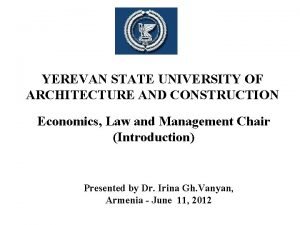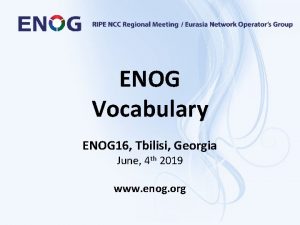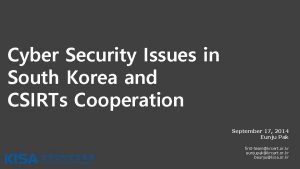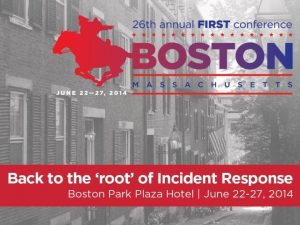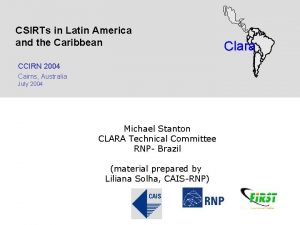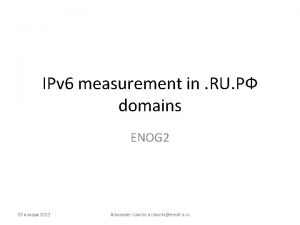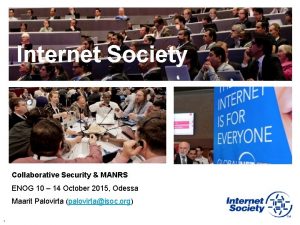The Case for National CSIRTs ENOG 12 Yerevan




















- Slides: 20

The Case for National CSIRTs ENOG 12 | Yerevan | 3 -4 Oct 2016

What is a CERT (CSIRT)? A Computer Security Incident Response Team (CSIRT) is a service organization that is responsible for receiving, reviewing, and responding to computer security incident reports and activity. Their services are usually performed for a defined constituency that could be a parent entity such as a corporation, governmental, or educational organization; a region or country; a research network; or a paid client. ” (CERT/CC)

What is a CSIRT? § Team within an organisation that prevents, manages and responds to information security incidents – Nominated person(s), typically in smaller organisations – Specialist team § Defined contact point – internally and externally § Historically responsive, CSIRTs increasingly focus on: – Prevention and Detection – Alerting – Vulnerability Analysis – Development of business continuity plans – Coordination with other CSIRTs

Recognised CSIRTs in ENOG region Country Armenia Azerbaijan Georgia Kazahkstan Moldova Russia Uzbekistan Kyrgyzstan Taijikistan Turkmenistan CSIRT CERT-AM Az. Science. CERT. AZ CERT. GOV. AZ CERT-GE CERT-GOV-GE KAZRENA-CERT KZ-CERT-GOV-MD MD-CERT-GIB Gov-CERT. RU RU-CERT Web. Plus ISP UZ-CERT None? Type National? R&E National? Government R&E cc. TLD Government National? Commercial Government TI Status Accredited Listed Accredited Listed

Why are CSIRTs important? § Security threats are real and ongoing § Ignoring threats costs resources – Denial-of-Service – Data Theft – Compromises reputations § Prevention is better than cure § Small things often prevent disasters § End user awareness reduces problems § CSIRTs save more than they cost, and offer possibility to offer value-added services

Why the need for National CSIRTs? § CSIRTs usually serve particular constituencies (e. g. government, academic, private sector) § Many security incidents are cross-constituency and international – Need for official national points of contact – Need for national focal point within country to coordinate incidents § Operational requirements for national constituencies can be different to other constituencies (e. g. 24 x 7 is more likely needed) § Key elements of Critical Infrastructure Protection

Why the need for National CSIRTs? § Internet has become critical to national economies – Share knowledge, resources and tools – Compare working practices – Develop common best practices and standards – Encourage development of CSIRTs and/or organisational points of contact. § Improve coordination with law enforcement, security and military agencies § Provision of technical advice on cybersecurity to policy makers. § EU called on all member states to establish National CSIRTs by 2011.

Different models for National CSIRTs § Host organisation – National Telecommunications Regulatory Body – Government CSIRT – Academic CSIRT (often these are the first CSIRTs established in a country) – Establishment of National Cybersecurity Centre § Voluntary vs Regulated – Relies on willingness of constituents to cooperate, or constituents are required to implement measures to counter threats (only in emergency situations? ) § Cooperation – Bi/multi-lateral or Community

Examples of National CSIRTs § CERT-GOV-MD (Moldova) – Operated by State Center for Special Telecommunications, provider of secure communications between government institutions § NCSC-NL (Netherlands) – Operated by Ministry of Security and Justice § Nor. CERT (Norway) – Operated by National Security Authority (NSM), under the Ministry of Defence § CERT. be (Belgium) – Operated by BELNET, the National Research & Education Network

How to establish a CSIRT? § Define basic framework – Mission Statement (what to do? ) – Definition of Constituency (for whom? ) – Relationship with others (who to cooperate with, and whom to trust? ) § Establish policies § Determine what services to offer § Train staff § Establish incident handling system § Raise awareness of CSIRT in your community § Establish contacts with other teams

Types of CSIRT services § Reactive – Vulnerability handling alerts – Incident & artefacts handling § Proactive – Announcements & information dissemination – Security audits – Development of security tools – Configuration & maintenance – Intrusion detection § Security Quality – Risk analysis – Disaster recovery planning – Consulting – Education – Product evaluation

The need to allocate resources to a CSIRT § Handling security is a service activity § Incidents require timely and effective response § Roles and responsibilities are important § A formal CSIRT structure is a requirement to join the Security Community and benefit from it § There must be somebody handling a security problem, whose priority is to solve the problem, or at least to take effective countermeasures § Establishing a minimal Service Level requires a minimal allocation of resources § Some incidents cannot be handled “best effort style”

The benefits of allocating resources to a CSIRT § Roles are defined, procedures are established § People know what to do and how § Increase in confidence by the community towards the CSIRT § Increase in confidence by the community towards the host organisation § Money costing resources (network infrastructure, data, computer services, manpower) are preserved and protected § Better reputation means better collaboration

The requirements for an operational CSIRT § Provide and keep updated information about itself and its services – Trusted Introducer Listing § Accomplish a list of operational requirements – MUST, SHOULD, MAY lists § Having operational tools that can solve/neutralize/mitigate security incidents § Belong to the Web-of-Trust of Security Teams – Trusted Introducer Accreditation process – FIRST membership

MUST… § Provide and make available PGP team and members keys § Provide and keep up-to-date Web site with contact information § Acknowledge incoming incidents and issue Trouble Tickets or Unique Identifiers § Inform external teams of unexpected security related discovered information § Provide incident closure information to the team who opened it § Use encryption to protect sensitive or personal data in incident handling information exchange § Keep all incident information confidential and not disclosed beyond the scope of incident handling § Sign all e-communications with PGP keys

SHOULD… § Document and publish Best Common Practices (BCP) § Make available its Communication and Authentication Policy for keys and certificates § Acknowledge incoming incident handling requests, and state its own Severity classification § Inform the external team about progress in handling incidents § Use a Trouble Ticket System (or equivalent) in handling procedures § Have PGP keys countersigned by other teams § Install and use security tools

MAY… § Inform the external team who opened an incident about the internal escalation procedures used § Redirect the external team who opened an incident to a more appropriate Security Team § Include automated information (IODEF-like) in reports exchanged with other teams § Make available X. 509 team and members certificates to other teams, including information about the Issuing Certification Authority, in case of Self Signed CA

Trusted Introducer § CSIRTs rely on notion of trust – whether contacts are trustworthy § Trusted Introducer service was introduced to establish higher level of trust § CSIRTs must provide specific information about personnel and services § Prospective CSIRTs must have support of at least two other TI- accredited CSIRTs, and others can object to acceptance § Accredited CSIRTs are contacted 3 times per year, and must respond to maintain accreditation § TI service is operated by TF-CSIRT, the European Forum of Computer Incident Response Teams, but open to all teams

TRANSITS Training § TF-CSIRT has produced training material for CSIRTs seeking relevant training § TRANSITS-I is 2 -day basic course covering organisational, technical operational and legal issues § TRANSITS-II is 3 -day advanced course covering traffic flow analysis, forensics, communication and incident handling exercises § Usually 2 x TRANSITS-I and 1 x TRANSITS-II workshop per year in Europe/Mediterranean/Middle East § TRANSITS materials adopted by FIRST who run workshops elsewhere in the world, and other organisations may also use materials under licence for their own training events § TRANSITS trainers can be hired for dedicated workshops

Thank You! Kevin Meynell meynell@isoc. org
 Enog
Enog Yerevan state university of architecture and construction
Yerevan state university of architecture and construction Yerevan opera
Yerevan opera Best worst and average case
Best worst and average case Fspos
Fspos Typiska novell drag
Typiska novell drag Nationell inriktning för artificiell intelligens
Nationell inriktning för artificiell intelligens Vad står k.r.å.k.a.n för
Vad står k.r.å.k.a.n för Varför kallas perioden 1918-1939 för mellankrigstiden
Varför kallas perioden 1918-1939 för mellankrigstiden En lathund för arbete med kontinuitetshantering
En lathund för arbete med kontinuitetshantering Kassaregister ideell förening
Kassaregister ideell förening Personlig tidbok
Personlig tidbok A gastrica
A gastrica Vad är densitet
Vad är densitet Datorkunskap för nybörjare
Datorkunskap för nybörjare Tack för att ni lyssnade bild
Tack för att ni lyssnade bild Debattartikel struktur
Debattartikel struktur Delegerande ledarstil
Delegerande ledarstil Nyckelkompetenser för livslångt lärande
Nyckelkompetenser för livslångt lärande Påbyggnader för flakfordon
Påbyggnader för flakfordon Formel för lufttryck
Formel för lufttryck

